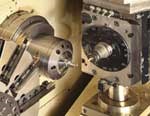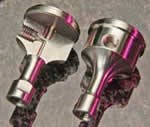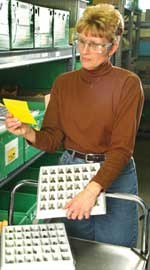OEM Transitions To Contract Manufacturer
An example of a perfect match, from one of the first customers Tier One landed, was a contract for 10,000 gearbox housings used in a stomach-suturing instrument. The process plan called for one operation on a CNC Swiss-type turning center and two additional operations on a CNC mill.
Four years ago, Tier One of Newtown, Connecticut, had a different company sign on the front lawn—Kendro Laboratory Products. Kendro is a 50-year-old producer of centrifuges for the medical and research industries. In 2003, the company decided to consolidate its assembly operations into a larger plant in Asheville, North Carolina, and to outsource the manufacturing of its motors, rotors and other precision parts produced in Newtown. Several ambitious managers from the machining department suggested that they continue to manufacture there and become Kendro’s vendor. Kendro owners approved, and Tier One, LLC was established with three principals, three shareholder positions for key management and 50 employees. While Kendro launched the business and remains a loyal customer, the goal from the start was to grow and diversify Tier One’s customer base.
Transitioning from an OEM to a contract shop spurred the need for a more agile environment at Tier One. The employees were used to making the same products using the same fixtures, the same tools, the same computer programs, and the same machines. As an OEM, the entire plant was practically running itself, even with the continuous improvement efforts called for in its lean manufacturing plan. Lean initiatives involved such tools and techniques as Kanban, Kaizen and achieving the highest ISO quality accreditation, which is ISO 9001:2000.
"It was certainly a different mindset when we launched Tier One because suddenly, we had to redefine ourselves to be a source for the companies we wanted to attract, rather than maintaining the status quo of a captive shop," says Joe Young, one of the Tier One principals. "We initiated a strategy to stay away from work that could be generated offshore. We wanted to be perceived as a solution-oriented firm providing low to medium volumes of highly engineered, function-critical parts as well as design services and assemblies as required. We identified medical as one industry we could serve well, along with aerospace and electronics. We had our share of hard lessons, which helped formalize our niche, so that now we only take on that which is in line with our capabilities. Further, we place a high value on meeting our commitments. It’s not easy to turn work away, believe me, but if it isn’t a good match, or if we can’t make the delivery, it’s best to be frank."
An example of a perfect match, from one of the first customers Tier One landed, was a contract for 10,000 gearbox housings used in a stomach-suturing instrument. The process plan called for one operation on a CNC Swiss-type turning center and two additional operations on a CNC mill. As the popularity of stomach stapling grew to combat obesity, so did the demand for suturing instruments and the volume of gear housings made at Tier One. Employees worked 6 days a week, three shifts per day, and the company acknowledged the need for more equipment capacity to keep the orders filled.
In seeking out suitable machinery, key staffers from Tier One did what many in manufacturing do when they are considering new equipment—went on a mission to the International Manufacturing Technology Show (IMTS) in 2004. The company and its operators were comfortable with all types of machine tools currently on the floor—CNC Swiss-types, milling machines, turning machines and grinders, plus a host of sophisticated measurement devices.
Don Stankus, director of manufacturing and stakeholder, spearheaded the mission. "Contemporary Swiss-type turning centers with live tools seemed like a smart solution or perhaps a mill/turn center of some sort," says Mr. Stankus. "We let all of the information we gathered gel for a while when we returned. We considered what we had seen in light of work we had in-house and work we wanted to get. One of the machines that peaked our interest at the show, and which we ultimately installed, was the TMU1 from Tsugami (REM Sales).
The TMU1 is a 1.5-inch-diameter-capacity Swiss-type machine with a unique feature—a fully automatic 60-station (118 optional) toolchanger serving its independent, 7.5-hp milling spindle. The main 15-hp spindle is a sliding headstock Swiss-type with an adjustable guide bushing. A 16-station front turret accepts two ID tools. Other features include full front and rear C axes and a B axis on the tool spindle with 210 degrees of positioning.
"With all of the machine features in play, we can now machine that gear housing part complete in one setup, reducing our cycle time by about 40 percent," says Mr. Stankus. "The bulk of the deburring was also accomplished in the machine, virtually eliminating the labor-intensive hand deburring that was being done in the multi-operation process."
It’s typical for medical companies to magnify parts 100 times to check for burrs and finish quality. Tier One has aggressive inspection procedures in place, more to simply ensure the quality they’re getting off the newest machine tools rather than to separate good and bad parts, which was the primary function of "quality control" in the past.
In process on the TMU1, the turret cutters, which can either plunge or traverse as required, are delivered to the 17-4 stainless workpiece as it inches out through the barstock guide bushing. The 16-tool turret services both the main and subspindle for the backworking functions. The subspindle has a stroke of 800 mm, allowing it to pickoff work from the main spindle. Its power and rotation speeds match the main spindle, essential for such operations as threading. Opposite the turret, and mounted on the compound slide, is a milling spindle that uses an integrated 2.2-kW motor providing 10,000 rpm for the milling and drilling operations. The most difficult aspect of the gear housing are the several off-center shaft holes (0.044 to 0.063), all requiring true position tolerances of ± 0.0003 inch. The live tool spindle’s B axis indexes from 15 to 195 degrees in 0.0001-degree increments. It is this spindle that is serviced by the machine’s automatic toolchanger. A double-arm mechanism accesses the tool storage unit.
According to Mr. Young, the biggest obstacle when the company first became a contract manufacturer was job start-ups. The company works three shifts, however, the process engineers and CNC programmers are employed on the first shift. If a machine was idle for first-run prototypes of a new job during shift one, that meant production was lost on shifts two and three also. Some of the older conventional CNC Swiss-type machines on the floor didn’t have the flexibility to switch from one part to another quickly enough. "While CNC has made these machines much more flexible than cam-types, it’s still a fairly lengthy tooling setup procedure to change from job to job," says Mr. Stankus.
To be successful in the contract world, it was critical that Tier One be able to start up new projects quickly to satisfy new customers, showing them with excellent quality and on-time deliveries, that they made the right decision in choosing Tier One. As such, another benefit of new Tsugami technology that Tier One installed is that they can do the brand new job work on the first shift and then switch over to a current production job on the second and third shifts.
"In less than 30 minutes, we’re changing over," says Mr. Stankus. "Flexibility is critical to us as we apply a ‘pull’ system here for orders on demand from our customers. We used to have to run all the first ops of the gear housing, stock them, and run the second ops when we received an order. That increased our work-in-process inventory, which isn’t ideal if you are trying to run as lean as possible. Now, our work-in-process is eliminated, which was easily about 300 pieces."
In addition to the productivity benefits surrounding the agility of storing tools for a host of jobs and the ability to complete jobs in one setup, the TMU1’s automatic toolchanger has a direct impact on tooling costs. Toolholders on a conventional CNC Swiss can cost as much as $3,500 each, particularly for the milling heads. Toolholders on the Tsugami cost about $150 each. Running the gear housing part in the traditional method cost $70,000 for tooling alone for the initial setup versus $5,000 on the TMU1. Projecting those costs throughout a decade or as long as the company retains the machine, the process engineers at Tier One quickly realized that the capital investment would return on the tooling cost savings alone.
Now almost 4 years-old, Tier One’s bet that they could make it as a contract shop looks like a winner. Their philosophy of only taking on a certain niche of high-level work is paying off for themselves and a customer list of almost two dozen companies with well-known brands. Far from patting themselves on their backs, however, the three principal owners, Mr. Young, Rick Hall and Mike Iassogna, tirelessly seek out new technology, techniques, and tweaks to make their business better. Their core values are lean manufacturing—always strive to improve, invest in employees, and make a profit.
"I can’t stress enough how big we are into lean manufacturing," says Mr. Young. "We run Kaisen events at least once a month, if not more."
A recent event involved changing the assembly area to improve the workflow and freed 2,000 square feet of space to grow into. At the rate Tier One is expanding its customer base, it will soon need the extra room.
Related Content
Swiss Happens: 8 Swiss-Type Articles to Keep Your Skills Sharp
Learn the history of Swiss-type lathes, practical ways to implement these sliding-headstock machines in your shop, and much more in this collection of articles.
Read MoreSucceeding at Swiss
McCormick Industries is no stranger to Swiss-type machining. Here are examples of ways the shop has found to become more efficient not only at using its CNC sliding-headstock machines, but at its overall shopfloor processes and practices, too.
Read More3 Stories of Swiss First Additions
A few shops share their stories about the how’s and why’s of adding their first Swiss-type CNC turning center as well as lessons learned along the way.
Read MoreSecond B Axis Improves Efficiency of Swiss-Type Machining
A highly stable, fully programmable B axis on the subspindle of Nomura DS’s 20J3XBTC enables users to more quickly machine complex parts complete.
Read MoreRead Next
First-Hand Experience Adds To Builder's Success
Near the foothills of one of the greatest mountain ranges in the world lies a family-owned machine tool builder specializing in Swiss machines. The story may sound familiar, but there’s a twist, as KSI Swiss is nowhere near the Alps.
Read MoreFinding the Right Tools for a Turning Shop
Xcelicut is a startup shop that has grown thanks to the right machines, cutting tools, grants and other resources.
Read MoreHow To (Better) Make a Micrometer
How does an inspection equipment manufacturer organize its factory floor? Join us as we explore the continuous improvement strategies and culture shifts The L.S. Starrett Co. is implementing across the over 500,000 square feet of its Athol, Massachusetts, headquarters.
Read More





%20automatic%20toolchanger.jpg;width=860)























